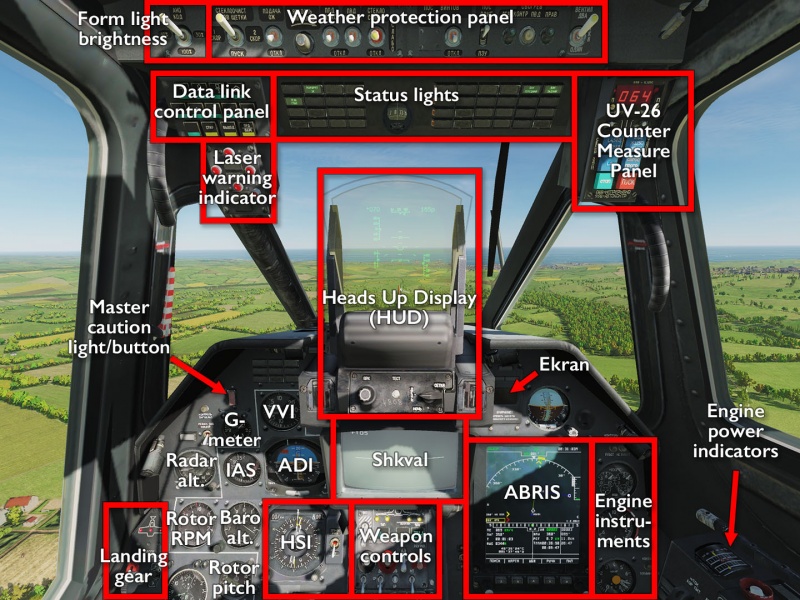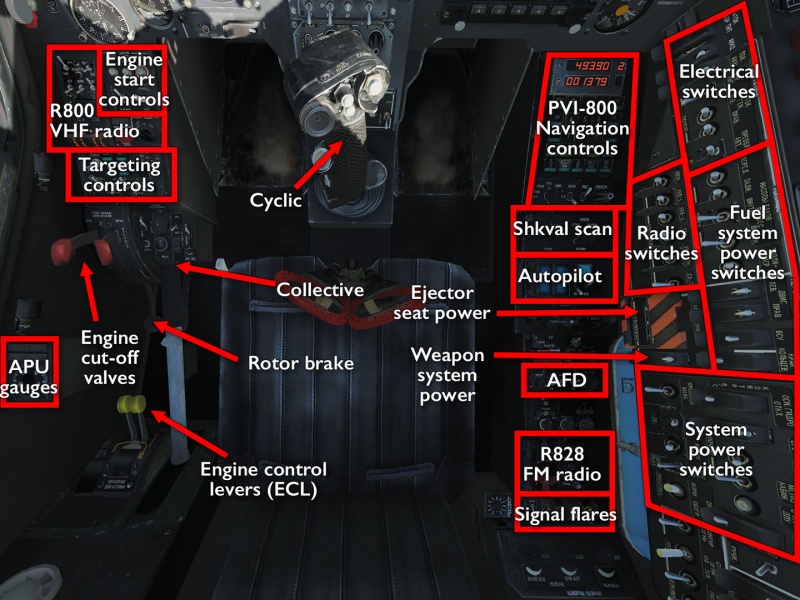Ka-50 Black Shark 2: Difference between revisions
m (→�) |
m (→�) |
||
| Line 45: | Line 45: | ||
[[File:Ka50-Pit.jpg|800px|frameless|Ka-50 Cockpit]] | [[File:Ka50-Pit.jpg|800px|frameless|Ka-50 Cockpit]] | ||
The Ka-50 has lots of controls — more even than is shown in the above images — but half of them are simply used to turn systems on at the before take-off, and off again when you return to base. The right wall panel contains most of the core system power switches, and the back panel over your right shoulder contains some setting dials, system tests, and advanced power switches. With the exception of ''maybe'' some of the lighting switches, in case a mission transitions from day to night, none of these need to be touched in flight. | |||
At least not until something catches fire and you need to start problem-solving. | |||
=== Getting into the air === | === Getting into the air === | ||
Revision as of 12:40, 23 June 2018
The Black Shark was the first module to be released for what was later to become DCS. Alongside the A-10C it was released as a separate simulator when it became clear that the old LOMAC game engine would not be a suitable basis for the sim. A while later, both games were re-envisoned as modules in a shared framework — DCS World — and Black Shark was revisited and re-relased as DCS: Black Shark 2.
The “Black Shark” in question is the single-seater Ka-50 attack helicopter, with the distinctive Kamov coaxial rotors — an advanced scouting and anti-tank helicopter that does away with the usual set-up of having flying, navigation, and weapons employment be split between a pilot and a co-pilot.
Features
To accomplish this feat, the Ka-50 comes equipped with a string of helper systems to aid and reduce the workload of the pilot:
- An advanced autopilot that manages engines and rotors to varying degrees — from simply giving acting as stabilisers and providing cyclic input cues, all the way to full flight automation and target- and route following.
- The Shkval electro-optical targeting system, including head-mounted aiming and automated target search.
- Laser-guided Vikhr and Kh-25ML missiles.
- A built-in adjustable 30mm auto cannon with automated aiming.
- Additional dumb weapons including free-fall bombs, cluster-munition dispensers, UPK-23 cannons, and S-13 and S-8 rockets.
- ABRIS on-board GPS-based navigation and PVI800 INS navigation systems with data linking.
- …and dual rotors. This cannot be stressed enough.
Comes with the built-in campaigns Deployment, Georgian Oil War, and Operation Medvedev II.
Flying the Ka-50
The Ka-50 is often compared to the A-10C because both are complex, systems-heavy, single-pilot attack aircraft. However, they are in many ways each other's exact opposites: the A-10C is easy to fly, but difficult to employ because of its complex set of sensors and weapons delivery modes. The Ka-50 has a very standardised way of delivering weapons, but is not easy to fly.
At the same time, the Ka-50 is often said to be the easiest of the DCS helicopters because of how much help the pilot gets from the built-in systems. Both perspectives are entirely true and accurate at once. The Ka-50 is easy to fly because the automation takes care of almost all the flying, but it is also difficult to fly exactly because you may end up fighting with that automation a lot unless you understand what it does and when and how it should be overridden or left alone. There is a complex interplay between stabilisation modes and trimming, all of which operate very differently than any other helicopter or fixed-wing airplane.
Autopilot modes
In truth, under normal circumstances, you do not so much fly the Ka-50 as program it, somewhat (but not entirely) like a fly-by-wire system in a regular airplane, but with far more authority and memory in relation to the pilot's inputs. New pilots that end up fighting the autopilot generally do so because one or more control channels have been left on with instructions that conflict with what the pilot actually wants, or because of increasingly out-of-whack trim settings.
The autopilot uses four main control channels to adjust the rotor pitch, attitude, and thrust:
- К (крен) — Bank dampener/bank hold.
- Т (тангаж) — Pitch dampener/pitch hold.
- Н (направление) — Heading/course hold:
- В (высота) — Altitude hold.
The cyclic trim button is used to set a desired bank and pitch angles, and the autopilot then try to maintain those angles until the respective channels are turned off or the pilot inputs new settings. The heading channel adjusts the total torque depending on whether it is supposed to track a target (targeting АДВ button), follow the current course (collective МАРШ switch) and/or follow a course or track heading (autopilot ЗК-ЛЗП switch), and also depending on whether rudder trim is turned on in the aircraft settings or no. The altitude hold adjusts rotor thrust depending on the collective brake, the ВИСЕНИЕ hover mode controlled from the cyclic, and on the collective СНИЖЕН switch.
The pitch and bank channels are generally always turned on, but can be dialled back from being automated hold modes to merely act as dampeners by engaging the flight director channel (ДИР УПР button). In this mode, the pilot has more direct control over pitch, bank, and thrust, and the required cyclic and collective input for the desired attitude is shown on the HUD — it is up to the pilot to align the helicopter datum with those cues.
Note: In the current 2.5 release and open beta versions, deferred shading makes the autopilot button lighting seem inverted: when “lit up” they appear darker and more dim than when a channel is turned off and the button light is not shining.
Cockpit overview
The Ka-50 has lots of controls — more even than is shown in the above images — but half of them are simply used to turn systems on at the before take-off, and off again when you return to base. The right wall panel contains most of the core system power switches, and the back panel over your right shoulder contains some setting dials, system tests, and advanced power switches. With the exception of maybe some of the lighting switches, in case a mission transitions from day to night, none of these need to be touched in flight.
At least not until something catches fire and you need to start problem-solving.
Getting into the air
Shooting something
Shkval
Weapon selection
ABRIS
Links and files
- Tippis' Checklist (see also kneeboard mods).
- Chuck's Ka-50 guide.
- DCS: Black Shark 2 in the DCS shop.
Related DCS modules
- Republic for Ka-50 campaign.
More information
- Kamov Ka-50 on wikpedia.
- Ka-50 HOKUM / Black Shark / Werewolf on globalsecurity.org
| DCS World | |
|---|---|
| Helicopter modules (full sim) |
Ka‑50 Black Shark 2 · Mi‑8MTV2 Magnificent Eight · Mi‑24P Hind · SA342L, M, Mistral, and Minigun Gazelle · UH‑1H Huey |






